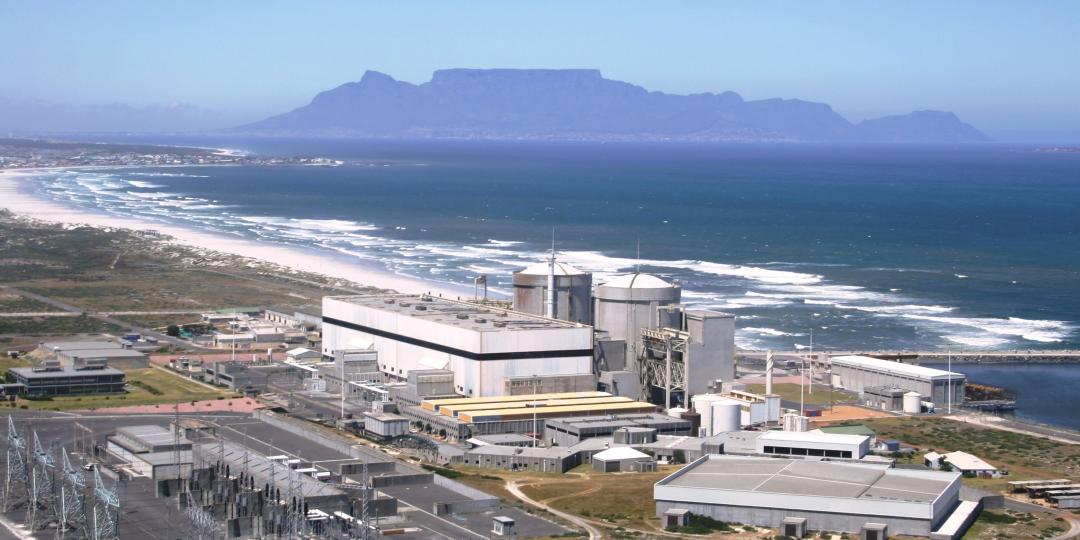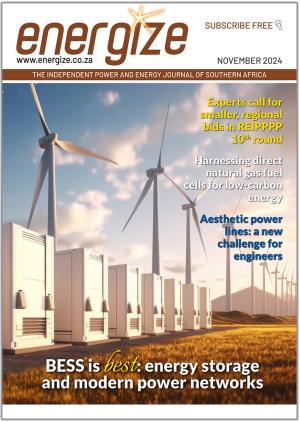by Chris Yelland, EE Business Intelligence
Preparations are underway for the replacement of the six steam generators at Eskom’s 1840 MW Koeberg nuclear power station, in what South Africa’s national electricity utility says is the most complex project ever undertaken at the nuclear facility since it was commissioned some 36 years ago in 1985.

Replacement of three of the steam generators on the 920 MW nuclear reactor Unit 2 is set to start in January 2022 in an outage planned to last 155 days. Thereafter, if all goes well, Eskom will commence the replacement of a second set of three steam generators on the 920 MW reactor Unit 1 in October 2022, in a similar 155-day planned outage.
In total, therefore, Eskom will be without at least 920 MW of base-supply from the nuclear power plant for some ten months between January 2022 and February 2023. This will serve to lower Eskom’s average energy availability factor (EAF) below the current EAF of 62% on Eskom’s fleet of power stations for the past 12 months, and to increase the probability of load-shedding during this period.
The steam generator replacement project is the largest part of a mid-life refurbishment and safety upgrade at the Koeberg nuclear power station. The current operating licence expires in 2024, and these upgrades are required by the National Nuclear Regulator (NNR) to extend the operating life of the nuclear facility by a further 20 years.
Budget and scope of work
The initial life-extension project was budgeted at R20-billion in 2010, and Eskom has confirmed that while there have been changes to the initial scope of work over the years, resulting from the findings of various studies and inspections conducted, the overall budget remains unchanged.
Eskom explains that there have been some additions to the scope of work, but that there have also been some exclusions – such as the replacement of the condenser tubes which is no longer considered necessary. Thus, overall, there is a reduced scope of work, although the overall budget remains at R20-billion in 2021 terms.
The biggest single item in the scope of work is the replacement of the steam generators at a cost of some R5-billion. Already there have been significant manufacturing problems and delays in the replacement of the steam generators from the initial planned completion date of 2018.
The three-year delay resulted from the scrapping of the initial steam generator forgings made in France, and the re-manufacture of the steam generators in China. However, Eskom says the extra costs involved have been borne by the contractor (Areva/Framatome), and that the overall cost of the steam generator replacement therefore remains within the original budget.
Major costs
A broad breakdown of the major items and costs making up the R20-billion scope of work for the life-extension works as disclosed by Eskom is given here:
- R5-billion: Replacement of the three steam generators on Unit 1 and the three steam generators on Unit 2, by Framatome/Areva.
- R7-billion: Balance of steam generator replacement project, including more than 20 additional plant modifications resulting from safety analyses and engineering studies; changes to the feedwater supply and heating systems, condensate extraction system, turbine steam control system and moisture separation system; other support contracts and site facilities; project management and licensing costs; interest during construction; and contingencies.
- R1-billion: Unit 1 reactor head, control rod drive mechanism and reactor in-core instrumentation cable replacement. The reactor head on Unit 2 was replaced in 2009/10 and is not included in the budget of R20-billion but was separately covered in the Koeberg maintenance and repair budget.
- R0,6-billion: Replacement and enlargement of the PTR storage tanks used to store borated water for the reactor cavity and spent fuel cooling system.
- R2-billion: Long-term outage specific maintenance and inspections resulting from the safety studies.
- R0,1-billion: Procurement for external event resilience – flexible emergency equipment to manage severe external events.
- Undisclosed cost: Repairs, modifications and monitoring of the reactor containment building to include cathodic protection to prevent corrosion of steel reinforcing (rebar) in the concrete.
- Undisclosed cost: Replacement of the heater elements on the pressurisers.
- Undisclosed cost: Other plant modifications and upgrades for reliability and sustainability, such as transformer replacements, digital system upgrades, security system upgrades, cooling water systems, piping and heat exchangers.
- Undisclosed cost: Ageing studies, investigations and safety reviews for the life-extension of the plant, and preparation of reports to the NNR, including the safety-case report to the NNR at the end of November 2021, for approval of the extension of the operating licence in 2024.
Exclusions
Eskom has indicated that the cost of repairs, refurbishment or replacement of electrical equipment such as high-, medium- and low-voltage switchgear, circuit breakers, transformers, electrical protection equipment and instrumentation are not included in the R20-billion life-extension budget, as these items fall within Koeberg’s normal maintenance budget.
Similarly, any work done on the steam turbines such as the replacement of the turbine rotors, and rewinding of the electric power generators, is not included in the R20-billion budget, but is covered by the normal maintenance budget. Eskom says there is extensive online condition monitoring equipment provided for the turbines and generators, and this work is therefore done as and when required and does not form part of the life-extension project.
Eskom also confirmed that repairs and maintenance of the cooling seawater intake to the power station is ongoing. The power utility added that the seawater intake is structurally sound, but due to the aggressive saltwater environment, civil work maintenance and repairs have been underway ever since the start of Koeberg. This work will continue for the next 20 years following the life-extension. Again, the utility says these costs do not form part of the R20-billion life extension budget, but are covered by the normal maintenance and repair budget for Koeberg.
Additional risks
At a recent media briefing, the power utility’s chief operating officer, Jan Oberholzer, indicated an additional risk to the Koeberg life-extension project resulting from the loss of key skilled personnel at the nuclear power plant. He stated that he was “nervous but confident” that the additional planning work done would enable Eskom to execute the works properly without any major issues.
However, the final safety-case report for the life-extension project must still be submitted by Eskom to the NNR by the end of November 2021 for approval. This presents a very tight timeline for Eskom to address any issues raised by the NNR, right over the festive season, before the first outage in January 2022.
The power utility cannot say for sure that there will be no surprises in the response from the NNR to its safety-case submission at the end of November 2021. However, unless there are some “curved balls” arising, it does not foresee any unexpected new requirements coming from the NNR.
In complex work of this nature, there is always a risk that unexpected and unanticipated problems and delays could arise, resulting in time overruns. Time overruns, whether due unforeseen technical, structural or other problems could result in Eskom having to shut the entire complex down resulting in a loss of over 1800 MW - something the power utility and the country cannot afford.
The utility however, believes that any such issues could be addressed within the normal course of events.
Let us hope that Eskom is right…
Send your comments to rogerl@nowmedia.co.za















